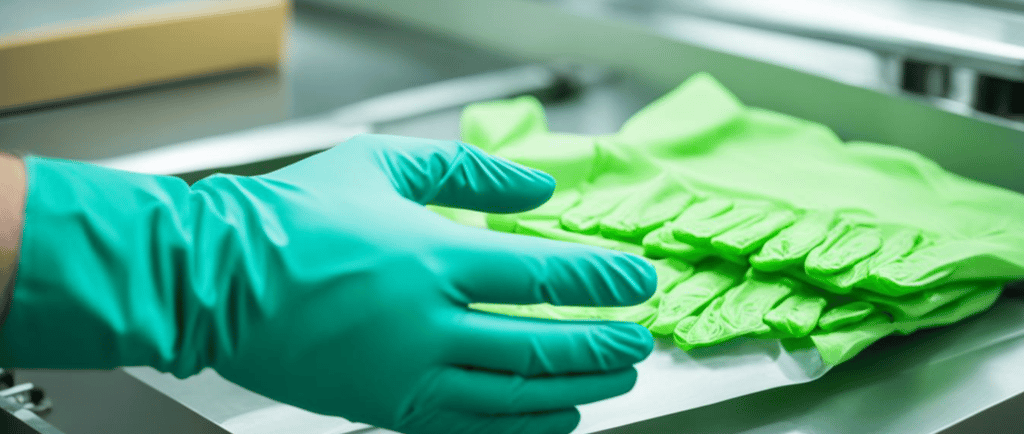✉︎ info@preserveearth.co.uk or WhatsApp Us

Benefits of Biodegradable Gloves in Manufacturing
DISPOSABLE GLOVES
7/1/202410 min read


Introduction
Every year, over 100 billion disposable gloves are used worldwide. In the UK, more than 110 million people work in jobs that need gloves for safety. This shows how widely these products are used. But, the use of non-biodegradable gloves is a big problem for the environment. They can take decades to break down in landfills, causing pollution and harming nature.
Biodegradable gloves are a better choice for the planet. They are made from plant based materials like cornstarch that can easily decompose. This means they have a lower environmental impact than traditional gloves. Using these gloves shows a company cares about the planet. It also helps reduce carbon emissions and supports a circular economy.
Key Takeaways
Biodegradable gloves are made from sustainable, plant-based materials that can decompose naturally, in contrast to traditional disposable gloves that can take decades to break down.
Adopting biodegradable gloves aligns with environmentally conscious manufacturing practices, reducing the environmental impact and contributing to a more circular economy.
Biodegradable gloves break down up to 5 times faster than conventional disposable gloves, leading to less waste generation and lower long-term pollution risks.
Choosing biodegradable gloves demonstrates a company's commitment to sustainability and supports their corporate social responsibility initiatives.
Biodegradable gloves offer the same level of protection and functionality as regular disposable gloves, making them a viable eco-friendly alternative for various manufacturing industries.
What are Biodegradable Gloves?
Definition and Materials
Biodegradable gloves are a special kind of protective gear. They break down naturally when thrown away, unlike traditional gloves that can take centuries. These eco-friendly disposable gloves are made from things like latex, cornstarch, or other biodegradable compounds. When they're composted or put in a special landfill, they turn into carbon dioxide, water, and organic matter. This reduces their harm to the environment.
The materials used in these gloves are chosen for their ability to break down and still protect and keep safe. They must be strong, flexible, and offer good barrier protection. This makes them good for many jobs, like in food prep, healthcare, and manufacturing.
Using biodegradable gloves is better for the planet than traditional ones. It cuts down on waste and lowers the harm to the environment. With more worry about plastic pollution, more people and companies want to use these eco-friendly disposable gloves. They aim to lessen their carbon footprint and support sustainable manufacturing.
"Biodegradable gloves are a game-changer in the world of personal protective equipment, offering a sustainable alternative that helps to protect both workers and the environment."
The Environmental Impact of Traditional Gloves
Traditional disposable gloves, like those made from nitrile, latex, or vinyl, use petroleum-based plastics. These plastics don't easily break down. They can take decades or even centuries to decompose, adding to plastic pollution. The COVID-19 pandemic has made this problem worse, as more gloves are being used and thrown away.
It's estimated that the healthcare sector uses about 300 billion disposable gloves every year. This huge number shows the big environmental problem with traditional gloves. They don't break down easily and can harm ecosystems and wildlife.
Traditional gloves can take up to 100 years to decompose. This is a big challenge for waste management. The way they are made also harms the environment, using non-renewable resources and causing greenhouse gas emissions.
"Every year, billions of traditional gloves end up in landfills, taking decades if not centuries to decompose, highlighting a significant environmental impact."
Switching to biodegradable gloves can lessen the environmental harm from disposable PPE. These gloves break down in months, cutting landfill waste by up to 30%. This helps reduce the load on landfills and supports a circular economy.
The need for eco-friendly medical products is growing. With better biodegradable materials and production, the future looks promising for sustainable gloves. As people become more aware of their environmental impact, more will choose biodegradable gloves. This will lead to more innovation and make these gloves more affordable.
Using biodegradable gloves can greatly reduce environmental harm. These gloves break down in a few years, unlike traditional ones which take decades. This is a big step towards solving the plastic pollution crisis and promoting better waste management.
The Positives of Biodegradable
Using biodegradable gloves in manufacturing has many benefits. These gloves come from renewable, plant-based materials. They break down naturally, cutting down plastic waste and lowering the environmental impact of disposable PPE.
Companies that use biodegradable gloves show they care for the planet. This supports sustainable practices and helps with corporate social responsibility (CSR) efforts.
Biodegradable gloves help create a circular economy. They use renewable resources and encourage a greener workplace. Natural rubber, for example, breaks down much faster than synthetic rubber, making these gloves a better choice for the environment.
The process of making these gloves is also more efficient, saving time and energy. This new method can cut down production time and energy use by up to 50%.
Producing sustainable latex gloves depends on natural rubber from rubber trees. These trees can be tapped for 28 years, supporting the use of renewable resources. This reduces the need for non-biodegradable materials like nitrile rubber.
Biodegradable gloves, including nitrile ones, break down into natural substances like water and carbon dioxide. This reduces plastic waste in landfills. Using these gloves helps lessen plastic pollution and its harm to ecosystems and wildlife.
Vinyl (PVC) gloves, on the other hand, don't break down. So, biodegradable gloves are a better choice for the environment. Biodegradable nitrile gloves have a special ingredient that speeds up their breakdown in landfills.
The price of biodegradable nitrile gloves has dropped in the last five years. They are now almost as affordable as standard nitrile gloves. Their environmental benefits make them a great choice for companies wanting to be more sustainable and lower their carbon footprint.
Biodegradation Process and Timelines
Understanding Biodegradation
The biodegradation of disposable gloves means they break down thanks to tiny organisms like bacteria and fungi. This happens with or without oxygen. Gloves made from plant based materials are made to degrade faster than those from petroleum.
Biodegradable gloves can take from 6 months to 2 years to fully break down. This is much quicker than non-biodegradable ones, reducing landfill time. This fast breakdown lessens the harm disposable gloves can cause to the environment.
But, not all biodegradable gloves are safe from harmful chemicals like lead and cadmium. It's key to dispose of them correctly, putting them in composting setups for proper breakdown.
Landfills don't have the right conditions for gloves to biodegrade well. They lack oxygen and sunlight. Composting facilities, on the other hand, help break down these gloves into carbon dioxide, water, and biomass as fast as cellulose.
It's vital to label things clearly and follow recycling advice to dispose of compostable gloves right. This stops them getting mixed up with recyclables. Knowing how gloves biodegrade helps both makers and users make choices that are better for the planet.
Regulatory Compliance and Certifications
The manufacturing sector has a big job to make sure the PPE they use is good for the environment. This includes disposable gloves. To prove they are eco-friendly, biodegradable gloves go through strict tests and get certifications.
Biodegradable gloves are tested against international standards like ASTM D5511 and ASTM D5526. These standards check how fast they break down. They also get certifications for resisting chemicals (EN374) and being safe for food (EN1186). This shows they're good for many jobs and meet the rules.
Manufacturers of biodegradable gloves also look for special certifications. These include the ISO 14001 environmental standard and the EU Ecolabel. These marks show the gloves are made with care for the planet and reduce their carbon footprint.
More and more, the industry is following these rules and getting these certifications for biodegradable gloves. This shows they care about the environment and want to offer eco-friendly PPE options. By focusing on sustainable manufacturing accreditations, they show they're leaders in making biodegradable gloves and eco-friendly PPE.
"Investing in gloves with proven performance and no harmful toxins could potentially justify the higher cost of nitrile gloves deemed 'biodegradable,' which lack clear benefits as per the presented evidence."
As we all want to use things that are better for the planet, having regulatory standards for biodegradable gloves and certifications for eco-friendly PPE is key. They help manufacturers make choices that are good for the earth.
Applications in Manufacturing Industries
Biodegradable gloves are used in many manufacturing industries because they are versatile and suitable for different work places. They are great for food processing, pharmaceuticals, chemicals, automotive, electronics, and more. These industries need hand protection.
These gloves are good for companies wanting to lessen their environmental impact. They keep workers safe and comfortable. They perform as well as traditional gloves but are better for the planet.
Versatility and Suitability
Biodegradable gloves without accelerators are less likely to cause skin reactions. This is good news for people with sensitive skin or allergies. They are perfect for healthcare, biotech, and labs.
These gloves offer great protection and are strong. They are ideal for those in healthcare, labs, and manufacturing who need reliable hand protection.
Key Features Benefits Accelerator-free composition. Reduced risk of allergic reactions for users with sensitive skin. Uncompromised barrier protection and durability. Suitable for healthcare, research, and manufacturing applications. Biodegradable and sustainable Eco-friendly choice for reducing environmental impact. Designed to meet performance standards. Effective hand protection without compromising on quality
The making of these gloves is cleaner, supporting a greener way to use disposable gloves. By choosing these gloves, companies lessen their environmental footprint. This is because they don't use accelerators and fewer chemicals.
"Hundreds of billions of single-use disposable gloves are used globally each year in the manufacturing sector. Biodegradable gloves offer a more sustainable solution that aligns with the growing demand for eco-friendly personal protective equipment in industrial settings."
Cost and Availability Considerations
As companies look to be more eco-friendly, the cost and ease of getting biodegradable gloves matter a lot. These gloves are better for the planet but might cost a bit more than the usual ones. This can stop some businesses from using them.
The high cost of biodegradable gloves comes from the special way they are made and the materials used. But, as more people want these eco-friendly options, prices are getting closer to traditional gloves. We're seeing more affordable biodegradable gloves from different companies.
As more companies want to be green, biodegradable gloves are becoming more appealing. They're getting cheaper and more businesses are using them to lessen their environmental impact.
Sustainable Manufacturing Practices
Using biodegradable gloves is part of a bigger move towards sustainable manufacturing practices and corporate social responsibility (CSR) in the industry. By choosing biodegradable gloves, companies show they care about reducing waste and lowering their environmental impact. This helps them work towards a more circular economy.
This focus on sustainability can make a company look better, boost employee morale, and draw in customers who care about the planet. Using biodegradable gloves also helps the industry move towards eco-friendly production methods and green initiatives in the workplace. This includes using renewable resources, cutting down on waste, and embracing circular economy ideas.
Aligning with Corporate Social Responsibility
Switching to biodegradable gloves shows a company's dedication to corporate social responsibility (CSR). It shows they're serious about being sustainable and taking care of the environment. This can make a company look better, attract customers who care about the planet, and make employees proud to work there.
Choosing biodegradable gloves is just one step in a set of sustainable manufacturing practices. These include:
Reducing waste and emissions
Using renewable energy
Making resources more efficient
Supporting circular economy ideas
Improving employee well-being and growth
These actions are good for the planet and help businesses stay strong and competitive over time.
By using biodegradable gloves and focusing on corporate social responsibility, companies can lead the way in their industry. They're seen as responsible and forward-thinking, ready to meet the changing needs of their customers and the global market.
Future Developments and Innovations
The need for sustainable manufacturing is growing fast. This means biodegradable gloves are set to get even better. Researchers and makers are looking into new innovative materials for eco-friendly PPE. They aim to make these eco-friendly protective gear break down faster, work better, and be cheaper.
New ideas might include using more renewable materials and better ways to break down the gloves. They might also add smart features to make workers safer and more comfortable. This could lead to more companies using emerging trends in sustainable manufacturing. It will help move towards a greener and more circular industry.
The biodegradable gloves market is expected to grow a lot, reaching $10.2 Billion by 2032. This is up from $1.1 Billion in 2021, with a growth rate of 23.0%. This growth is driven by the increasing need for nitrile gloves. The future of compostable protective gear looks bright as companies work on new solutions. These solutions must meet both environmental and performance standards.
We can look forward to more advancements in biodegradable glove technology. These will include materials that are good for the planet and also better for workers in various industries.
Conclusion
Biodegradable gloves are a green choice compared to traditional disposable ones. They help tackle the environmental issues linked to non-biodegradable PPE. Using these gloves made from plants cuts down plastic waste and supports renewable resources. It also fits well with the circular economy goals.
Choosing biodegradable gloves makes the workplace greener and boosts employee happiness. It also makes a company look better to eco-aware customers and stakeholders. As more people want sustainable options, biodegradable gloves are set to grow in popularity. New improvements in materials and production are making them even better for industries.
The benefits of biodegradable gloves, the push for sustainable manufacturing, and the future of eco-friendly PPE show their big role. They are key to a greener and more responsible future for manufacturing.
FAQ
What are biodegradable gloves?
Biodegradable gloves are special PPE that can break down naturally when thrown away. They are made from things like plants, unlike traditional gloves that take centuries to decay. These gloves are good for the planet.
How do biodegradable gloves differ from traditional disposable gloves?
Unlike regular gloves, biodegradable ones don't use petroleum-based plastics. They come from renewable sources and can break down quickly. This means they don't harm the environment like traditional gloves do.
What are the environmental benefits of using biodegradable gloves in manufacturing?
Using biodegradable gloves helps the planet in many ways. They're made from things that can naturally decompose, so they don't add to plastic waste. This shows companies care about the environment and their social responsibility.
How long do biodegradable gloves take to decompose?
Biodegradable gloves can break down in 6 months to 2 years. This is much faster than non-biodegradable ones. This quick breakdown reduces the harm they cause to the environment.
What certifications and standards are associated with biodegradable gloves?
Biodegradable gloves meet strict standards like ASTM D5511 and EN374. They also get certifications for being eco-friendly. This ensures they're safe for use and good for the planet.
In what industries are biodegradable gloves used?
Biodegradable gloves are used in many industries. This includes food, pharmaceuticals, chemicals, and more. They're a great choice for companies wanting to be eco-friendly without sacrificing safety.
What are the cost and availability considerations for biodegradable gloves?
Biodegradable gloves might cost a bit more than others. But prices are getting closer as more companies make them. There are many suppliers offering these eco-friendly gloves at good prices.
How do biodegradable gloves align with sustainable manufacturing practices?
Using biodegradable gloves shows a company cares about the planet. It helps reduce waste and supports a circular economy. This can make a company more respected and attract customers who care about the environment.
What future developments and innovations are expected in the biodegradable gloves market?
The demand for eco-friendly gloves is growing, leading to new improvements. Researchers are looking into better materials and ways to make them. We might see smarter gloves that are safer and more comfortable for workers.

Follow Us
Company Number: 15482817
Preserve Earth, 2025. All Rights Reserved.


